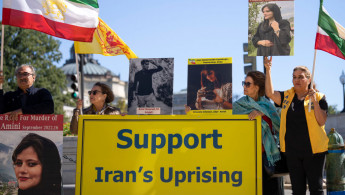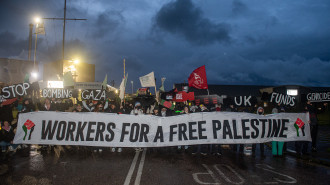Why Iran's Mahsa Amini protests are a turning point
Twelve days into deadly, widespread protests across dozens of cities in Iran triggered by the death of 22-year-old woman Mahsa Amini in police custody, the slogan of "woman, life, freedom" has morphed into "death to dictatorship".
Protestors and exiled Iranian activists who spoke to The New Arab expressed both hopes and trepidations about the trajectory of the uprising, but they all agreed the unrest could be different from previous episodes.
Nader, a 38-year-old resident of Kerman - the birthplace of Qassem Soleimani, the commander of the Quds Force who expanded Iran's influence in the Middle East, and was killed in Baghdad by US strike in January 2020 - says that for the first time in recent memory, the protests have lasted for twelve consecutive days and nights.
“In 1999, 2009 and 2019, there were electoral and economic protests, but they did not last long. This time, even after cutting off the internet, they could not stop people", he said. "The graffiti against the regime also started appearing in Kerman; at night, protesters write death to Khamenei, and in the day, the government cleans it up," he added.
Iranian women are leading the protests side by side with men. The immediate spark has been the heavy-handed enforcement of the Islamic dress code on women: Amini had been arrested for wearing 'improper clothing' by Tehran's so-called morality police and then died in a hospital after spending three days in a coma. The authorities have been accused of assaulting her but the Iranian government said that Mahsa Amini's death was due to pre-existing a health condition and accused foreign plotters of inciting 'riots' in the country.
At least 76 protesters are thought to have died during the anti-government protests.
Beyond the enforced hijab issue, many Iranians also feel let down by decades of rigged elections, economic mismanagement, and theocratic rule. Their protests are also reverberating around the world from London to Rome and from Syria to Canada. The name of Mahsa Amini has been hashtagged more than a hundred million times.
Masih Alinejad, a US-based advocate of Iranian women's rights who shares around the clock videos of the protesters to millions of followers, believes that the situation has reached a turning point. She says that the West should stop the nuclear talks with the Iranian government: "Don't keep dictators and stop negotiations with the killers of Iranian women", she has appealed to the Western powers.
Dear Americans &Europeans please listen:
— Masih Alinejad 🏳️ (@AlinejadMasih) September 28, 2022
Iranians are endangering their lives for freedom. Soon, they’ll start national strikes.
Your emphasis on a nuclear deal will send billions of cash to kill more innocent people like #MahsaAmini.@MSNBC#مهسا_امینیpic.twitter.com/lbRADqqtfH
The Iranian women's rights activist said that the protests are primarily against the repressive regime. She thinks the regime could be on its last legs.
"It is a lie that they say that the Islamic Republic is not going to fall. The reality is that the Akhunds' - Shia religious scholars - regime is taking its last breaths. The people have made their decision. The protesters are not going to leave the streets and will not hesitate to overthrow the oppressors," she added.
Shirin, a 32-year-old resident of Mashhad - the birthplace of Khamenei, supreme leader of the Islamic Republic - who is one of the protesters on the streets, says that the Iranian people are frustrated and have nothing to lose anymore.
"We are determined to end this authoritarian regime. The dictatorial regime is no longer acceptable. Our desire is no longer standing against compulsory hijab, but the end of the Islamic Republic regime," she adds. Shirin believes that if these protests are further suppressed, blood will flow and another spark will uproot the Islamic Republic regime.
When the regime is able to suppress the armed opposition against Bashar al-Assad, and could keep a dictator, then it is not willing to end its survival so easily. I saw how dictatorships survived with cruelty and bullets --- Qadir, a 30-year-old resident of Tehran
But Qadir, a 30-year-old resident of Tehran, although he supports the protests, says he is worried that his country could suffer the fate of nations like Yemen and Syria. "You can't do anything with excitement. Protests are nothing new in Iran. The protests have now turned into riots. This is worrying and I am afraid for the future," he added.
Qadir says that the Islamic Republic, with its 43-year experience of repression and direct and proxy wars in the Middle East, will not surrender to the protesters.
"When the regime is able to suppress the armed opposition against Bashar al-Assad, and could keep a dictator, then it is not willing to end its survival so easily. I saw how dictatorships survived with cruelty and bullets," he added.
In 1979, Iran's Shah, Mohammad Reza Pahlavi, was overthrown by an Islamic Revolution led by Ayatollah Ruhollah Khomeini, who became supreme leader. After his death, Ali Khamenei became the new leader in 1989.
Afshin Shahi, associate professor of Middle East studies at the university of Bradford in England, says that it is indeed a critical moment in state-society relations in Iran.
"In a country which has been ruled by a repressive Shia state, a Sunni Kurdish girl who was killed at the hands of the ‘morality police’ is becoming a symbol of political renewal in Iran".
“Over the last ten days [now 12] the protesters' fear is fading away. The fear factor is very important for a state facing a profound crisis of legitimacy. The state primarily depends on violent mechanisms of social control to maintain the status quo, so obviously, if people are no longer fearful of the state, the Islamic Republic has very little to cling to," he added.
“We are witnessing a new culture of descent in Iran. Ethnic, linguistic and social divides are no longer important variables in creating an arena of protests against the Islamic Republic. I genuinely think even if they could suppress the protests by violence, something fundamental has changed in Iran which has created a ticking bomb for the regime".
Abu Muslim Shirzad is a university lecturer and researcher on security and political matters of South Asia, Central Asia and the Middle East.





 Follow the Middle East's top stories in English at The New Arab on Google News
Follow the Middle East's top stories in English at The New Arab on Google News


